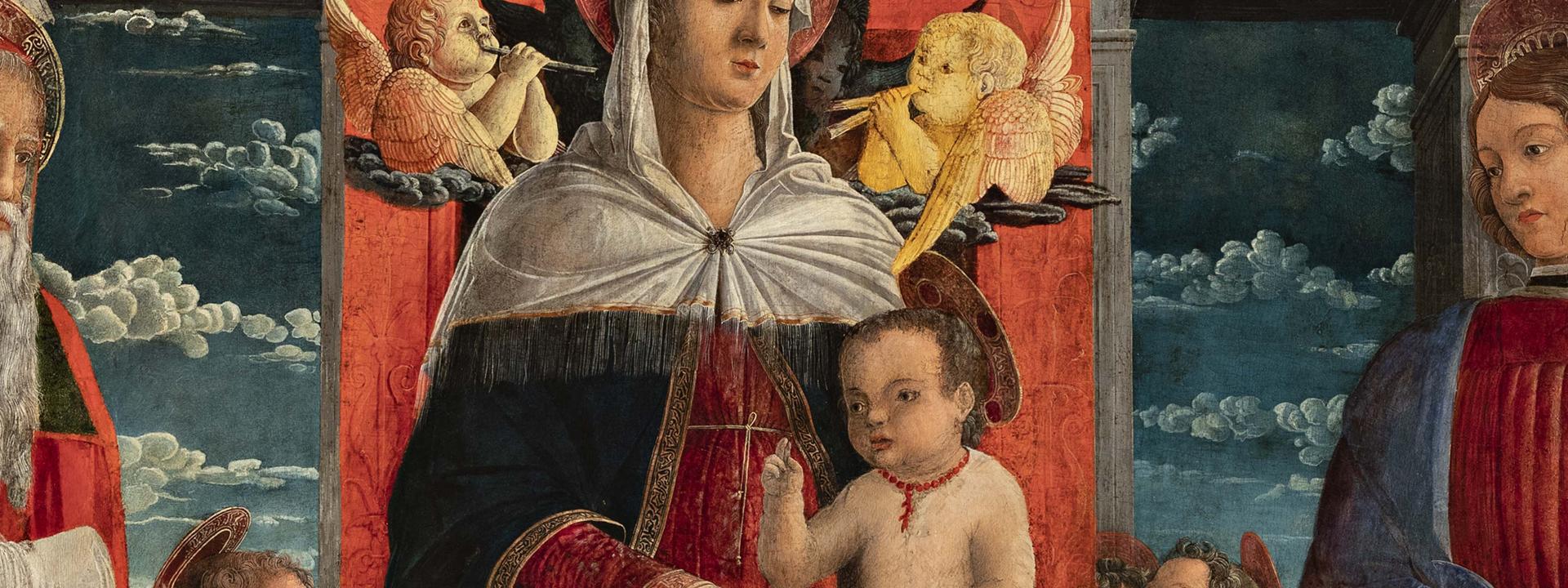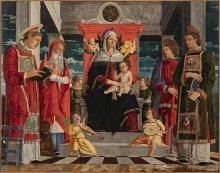From the convent of Santo Stefano in Padua and acquired by the Gallerie dell’Accademia in 1853, the work has been variously attributed by scholars to Pier Maria Pennacchi, Jacopo da Montagna, Gentile Bellini, and Francesco Benaglio amongst others, without ever reaching a fully convincing or unanimous consensus. The painting is most certainly closely related to the innovative compositional framework of Andrea Mantegna’s triptych the San Zeno Altarpiece (1456–1459, Verona, Basilica of San Zeno). The porticoed marble structure, the saints depicted as they are deep in meditation, the raised classically-styled throne on which the Virgin and Child are seated while surrounded by a concert of little angels, the chequered floor, the bas reliefs along the trabeation, and the fluffy clouds all derive from this altarpiece. The reference to Benaglio – a Veronese artist who renewed the local, Gothically-inspired artistic language thanks to his dealing with the works of Squarcione, Mantegna, and Piero della Francesca – is due to a comparison between the work in question and the only work that is unequivocally by the artist, the Triptych of San Bernardino (1462–1463, Verona, church of San Bernardino), where the commissioners certainly asked for a reference to Mantegna’s polyptych. In keeping with Benaglio’s style are the “marmi mischi” (marble inlay work) and the “tube-like” pleats of the garments, but the squared headcovering and the Virgin’s oval face – which can be found in other works by Benaglio such as his Madonna and Child (Madonna del Ventaglio), Verona, Museo di Castelvecchio – are not present in the Gallerie painting, like the rich series of decorative details and elements that are so redolent in his Triptych of San Bernardino. Specialist scholars are still debating the attribution to Benaglio.
- Visit
- What's on
- On-line collections
- SEATS
- Exhibitions
- EDUCATION PROGRAMMES
- Online Activities
- Artworks not on display
- SPACES AND IMAGES CONCESSIONS
- SUPPORT US
-
TRANSPARENT ADMINISTRATION
- GENERAL PROVISIONS
- ORGANISATION
- CONSULTANTS AND COLLABORATORS
- STAFF
- PERFORMANCE
- Bandi e gare
- CONTRACTS
- Determine
- PROVVEDIMENTI
- BALANCE SHEETS
- GRANTS, CONTRIBUTIONS, SUBSIDIES, ECONOMIC ADVANTAGES
- ADMINISTRATIVE PAYMENTS
- LEGAL PROCEDURES
- ADMINISTRATIVE SUPERVISION AND EVALUATION
- ACCESSO CIVICO
- SERVICES PROVIDED
- OTHER CONTENTS
- CREDITS
- CONTACT
- English
- italiano





